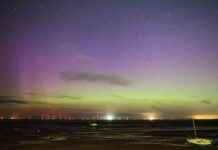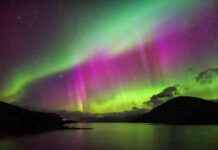As the weekend approaches, sky gazers and nature enthusiasts are eagerly anticipating a spectacular display of the Northern Lights across mid-latitude locations in North America. This cosmic event is the result of recent solar activity that has energized the Earth’s atmosphere with charged particles, creating the perfect conditions for the aurora borealis to make an appearance.
The Science Behind the Spectacle
The stunning display of the Northern Lights is a result of violent solar explosions that release solar material into space. When these charged particles interact with Earth’s atmosphere, particularly with oxygen and nitrogen gases, they create dazzling displays of color. Oxygen produces green and red hues, while nitrogen contributes blues and purples to the mix, resulting in the vibrant colors seen in the auroras.
The current prediction for geomagnetic activity rates is at a moderate G2 level, indicating that this weekend’s auroras are expected to be vivid and extensive. Geomagnetic storms are rated on a scale from G1 to G5, with higher levels producing more intense auroral shows. This weekend’s forecast promises an exciting opportunity for aurora enthusiasts to witness the beauty of the Northern Lights.
Where to See the Colors
If you are hoping to witness the Northern Lights this weekend, specific locations in the northern U.S. and Canada are more favorable for viewing. States like Alaska, Minnesota, Wisconsin, South Dakota, and even New York have a chance of spotting the auroras. In Canada, locations such as the Northwest Territories and Yukon are known for their frequent aurora displays due to their proximity to the pole.
For the best viewing experience, it is recommended to travel to areas with minimal light pollution and clear skies. The optimal time to catch a glimpse of the auroras is between 10 p.m. and 2 a.m. local time, aligning with the expected peak activity of the geomagnetic storm. Patience and monitoring the evolving conditions are key to witnessing the mesmerizing Northern Lights.
Capturing the Moment
Photography enthusiasts can also capture the beauty of the Northern Lights with the advancement of smartphone cameras. Tips for photographing the auroras include using night mode for enhanced exposure, using a tripod for stability, and shooting in low light areas away from city lights to avoid light pollution. Weather conditions, such as clear skies, are essential for successful photography attempts.
What Lies Ahead
As we enter a period of heightened solar activity, researchers predict more frequent and intense geomagnetic storms leading up to the sun’s maximum phase around late 2024 to early 2026. This presents multiple opportunities for skywatchers to witness the awe-inspiring Northern Lights in the coming months. Factors like solar wind speed and magnetic field orientation will significantly influence the visibility of the auroras.
An Invitation to Marvel at Nature
The Northern Lights serve as a reminder of the beauty and complexity of the natural world, connecting us to the forces of the universe. As we prepare to witness this captivating display this weekend, it is a chance for everyone to appreciate the wonder of auroras firsthand. Whether you are standing beneath a shimmering sky alone or sharing the experience with loved ones, the Northern Lights offer a unique opportunity to marvel at the beauty of our cosmos and our connection to the world beyond.
So, as the weekend approaches, be sure to grab your warm layers and head outdoors to witness the Northern Lights dance above your head. The enchanting display of colors across the skies is a sight not to be missed, providing a magical experience that reminds us of the vast wonders of our universe.



